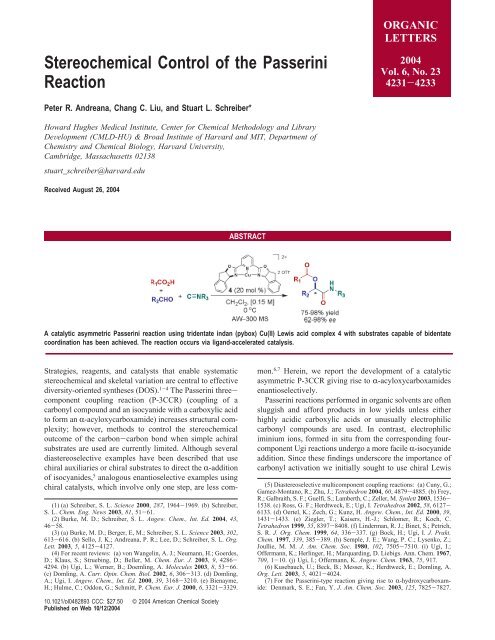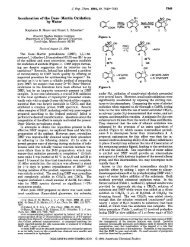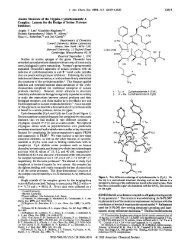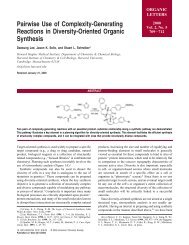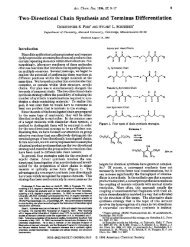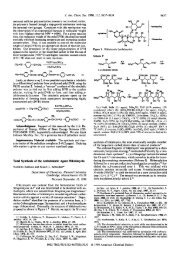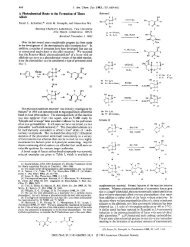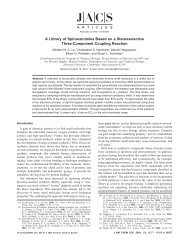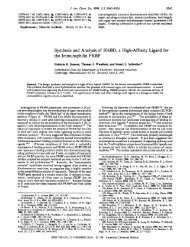Stereochemical Control of the Passerini Reaction - American ...
Stereochemical Control of the Passerini Reaction - American ...
Stereochemical Control of the Passerini Reaction - American ...
You also want an ePaper? Increase the reach of your titles
YUMPU automatically turns print PDFs into web optimized ePapers that Google loves.
<strong>Stereochemical</strong> <strong>Control</strong> <strong>of</strong> <strong>the</strong> <strong>Passerini</strong><br />
<strong>Reaction</strong><br />
ORGANIC<br />
LETTERS<br />
2004<br />
Vol. 6, No. 23<br />
4231-4233<br />
Peter R. Andreana, Chang C. Liu, and Stuart L. Schreiber*<br />
Howard Hughes Medical Institute, Center for Chemical Methodology and Library<br />
DeVelopment (CMLD-HU) & Broad Institute <strong>of</strong> HarVard and MIT, Department <strong>of</strong><br />
Chemistry and Chemical Biology, HarVard UniVersity,<br />
Cambridge, Massachusetts 02138<br />
stuart_schreiber@harVard.edu<br />
Received August 26, 2004<br />
ABSTRACT<br />
A catalytic asymmetric <strong>Passerini</strong> reaction using tridentate indan (pybox) Cu(II) Lewis acid complex 4 with substrates capable <strong>of</strong> bidentate<br />
coordination has been achieved. The reaction occurs via ligand-accelerated catalysis.<br />
(1) (a) Schreiber, S. L. Science 2000, 287, 1964-1969. (b) Schreiber,<br />
S. L. Chem. Eng. News 2003, 81, 51-61.<br />
(2) Burke, M. D.; Schreiber, S. L. Angew. Chem., Int. Ed. 2004, 43,<br />
46-58.<br />
(3) (a) Burke, M. D.; Berger, E, M.; Schreiber, S. L. Science 2003, 302,<br />
613-616. (b) Sello, J. K.; Andreana, P. R.; Lee, D.; Schreiber, S. L. Org.<br />
Lett. 2003, 5, 4125-4127.<br />
(4) For recent reviews: (a) von Wangelin, A. J.; Neumann, H.; Goerdes,<br />
D.; Klaus, S.; Struebing, D.; Beller, M. Chem. Eur. J. 2003, 9, 4286-<br />
4294. (b) Ugi, L.; Werner, B.; Doemling, A. Molecules 2003, 8, 53-66.<br />
(c) Domling, A. Curr. Opin. Chem. Biol. 2002, 6, 306-313. (d) Domling,<br />
A.; Ugi, I. Angew. Chem., Int. Ed. 2000, 39, 3168-3210. (e) Bienayme,<br />
H.; Hulme, C.; Oddon, G.; Schmitt, P. Chem. Eur. J. 2000, 6, 3321-3329.<br />
Strategies, reagents, and catalysts that enable systematic<br />
stereochemical and skeletal variation are central to effective<br />
diversity-oriented syn<strong>the</strong>ses (DOS). 1-4 The <strong>Passerini</strong> threecomponent<br />
coupling reaction (P-3CCR) (coupling <strong>of</strong> a<br />
carbonyl compound and an isocyanide with a carboxylic acid<br />
to form an R-acyloxycarboxamide) increases structural complexity;<br />
however, methods to control <strong>the</strong> stereochemical<br />
outcome <strong>of</strong> <strong>the</strong> carbon-carbon bond when simple achiral<br />
substrates are used are currently limited. Although several<br />
diastereoselective examples have been described that use<br />
chiral auxiliaries or chiral substrates to direct <strong>the</strong> R-addition<br />
<strong>of</strong> isocyanides, 5 analogous enantioselective examples using<br />
chiral catalysts, which involve only one step, are less common.<br />
6,7 Herein, we report <strong>the</strong> development <strong>of</strong> a catalytic<br />
asymmetric P-3CCR giving rise to R-acyloxycarboxamides<br />
enantioselectively.<br />
<strong>Passerini</strong> reactions performed in organic solvents are <strong>of</strong>ten<br />
sluggish and afford products in low yields unless ei<strong>the</strong>r<br />
highly acidic carboxylic acids or unusually electrophilic<br />
carbonyl compounds are used. In contrast, electrophilic<br />
iminium ions, formed in situ from <strong>the</strong> corresponding fourcomponent<br />
Ugi reactions undergo a more facile R-isocyanide<br />
addition. Since <strong>the</strong>se findings underscore <strong>the</strong> importance <strong>of</strong><br />
carbonyl activation we initially sought to use chiral Lewis<br />
(5) Diastereoselective multicomponent coupling reactions: (a) Cuny, G.;<br />
Gamez-Montano, R.; Zhu, J.; Tetrahedron 2004, 60, 4879-4885. (b) Frey,<br />
R.; Galbraith, S. F.; Guelfi, S.; Lamberth, C.; Zeller, M. Synlett 2003, 1536-<br />
1538. (c) Ross, G. F.; Herdtweck, E.; Ugi, I. Tetrahedron 2002, 58, 6127-<br />
6133. (d) Oertel, K.; Zech, G.; Kunz, H. Angew. Chem., Int. Ed. 2000, 39,<br />
1431-1433. (e) Ziegler, T.; Kaisers, H.-J.; Schlomer, R.; Koch, C.<br />
Tetrahedron 1999, 55, 8397-8408. (f) Linderman, R. J.; Binet, S.; Petrich,<br />
S. R. J. Org. Chem. 1999, 64, 336-337. (g) Bock, H.; Ugi, I. J. Prakt.<br />
Chem. 1997, 339, 385-389. (h) Semple, J. E.; Wang, P. C.; Lysenko, Z.;<br />
Joullie, M. M. J. Am. Chem. Soc. 1980, 102, 7505-7510. (i) Ugi, I.;<br />
Offermann, K.; Herlinger, H.; Marquarding, D. Liebigs. Ann. Chem. 1967,<br />
709, 1-10. (j) Ugi, I.; Offermann, K. Angew. Chem. 1963, 75, 917.<br />
(6) Kusebauch, U.; Beck, B.; Messer, K.; Herdtweck, E.; Domling, A.<br />
Org. Lett. 2003, 5, 4021-4024.<br />
(7) For <strong>the</strong> <strong>Passerini</strong>-type reaction giving rise to R-hydroxycarboxamide:<br />
Denmark, S. E.; Fan, Y. J. Am. Chem. Soc. 2003, 125, 7825-7827.<br />
10.1021/ol0482893 CCC: $27.50<br />
Published on Web 10/12/2004<br />
© 2004 <strong>American</strong> Chemical Society
acid chelation control with Cu(II)-derived Lewis acids to control<br />
<strong>the</strong> configurational outcome <strong>of</strong> <strong>the</strong> P-3CCR. 8 Importantly,<br />
<strong>the</strong>se conditions are sufficiently mild to be compatible<br />
with a one bead/one stock solution technology platform. 9<br />
Our approach uses a Cu(II) complex and bidentate<br />
coordination with carbonyl substrates as a means to invoke<br />
stereocontrol <strong>of</strong> <strong>the</strong> newly formed C-C bond. Initial studies<br />
used bidentate (S,S)-bis(oxazolinyl) (box) (1 and 2)sCu(II)<br />
and tridentate bis(oxazolinyl)pyridine (pybox) (3 and 4)s<br />
Cu(II) complexes. 8,10 The reactions were performed in <strong>the</strong><br />
presence <strong>of</strong> benzoic acid (5), (benzyloxy)acetaldehyde (6),<br />
and p-methoxyphenyl isocyanide (7) (Table 1). The ligand<br />
screen revealed that bispybox 4, derived from (1S,2R)-<br />
aminoindanol, was able to control <strong>the</strong> R-addition <strong>of</strong> <strong>the</strong><br />
isocyanide with superior enantioselectivity and yield (entry<br />
7, Table 1).<br />
Table 1.<br />
Optimization for <strong>the</strong> Lewis Acid Catalyzed P-3CCR<br />
entry a catalyst b time (h) (0 °C) [conc] (M) % yield c %ee d<br />
1 1a 18 0.25 71 50<br />
2 1b e 18 0.25 63 56<br />
3 2a 14 0.50 93 64<br />
4 2b e 8 0.50 87 63<br />
5 3a 18 0.25 90 85<br />
6 3b e 18 0.25 86 79<br />
7 4 f 18 0.15 93 97<br />
8 g 36 (40 °C) 0.15
Table 2.<br />
Generality <strong>of</strong> <strong>the</strong> Catalyzed P-3CCR Using Cu(II) Indan Pybox Catalyst<br />
entry a R 1 R 2 R 3 product % yield b %ee c<br />
1 PhCH 2 (9) 2-furyl (10) PhCH 2 (11) 16 83 62 (R) d<br />
2 PhCH 2 (9) BnOCH 2 (6) PhCH 2 (11) 17 87 72<br />
3 Ph (5) 2-thiophenecarboxyl (12) t-butyl (13) 18 95 82 (R)<br />
4 Ph (5) BnOCH 2 (6) n-butyl (14) 19 87 88<br />
5 Ph (5) BnOCH 2 (6) n-pentyl (15) 20 83 89<br />
6 Ph (5) BnOCH 2 (6) PhCH 2 (11) 21 89 93<br />
7 Ph (5) BnOCH 2 (6) t-butyl (13) 22 95 98<br />
8 Ph (5) 2-furyl (10) p-MeOPh (7) 23 98 91 (R)<br />
9 Ph (5) 2-furyl (10) PhCH 2 (11) 24 90 75 (R)<br />
10 Ph (5) 2-furyl (10) t-butyl (13) 25 97 89 (R)<br />
11 Ph (5) 2-furyl (10) n-butyl (14) 26 82 78 (R)<br />
12 Ph (5) 2-furyl (10) n-pentyl (15) 27 82 78 (R)<br />
13 Ph (5) 2-thiophenecarboxyl (12) p-MeOPh (7) 28 95 89 (R)<br />
14 Ph (5) 2-thiophenecarboxyl (12) PhCH 2 (11) 29 87 75 (R)<br />
15 Ph (5) 2-thiophenecarboxyl (12) n-butyl (14) 30 76 64 (R)<br />
16 Ph (5) 2-thiophenecarboxyl (12) n-pentyl (15) 31 75 60 (R)<br />
a [0.15 M] final. b Isolated yield. c See <strong>the</strong> Supporting Information for HPLC conditions. d Inferred absolute stereochemistry based on X-ray crystal analysis<br />
with 5-bromo-2-furaldehyde as <strong>the</strong> substrate.<br />
complex molecular skeleton by generating a product-equalssubstrate<br />
intermediate. Scheme 1 illustrates <strong>the</strong> use <strong>of</strong><br />
components that give rise to a consecutive P-3CC/intramolecular<br />
Diels-Alder reaction producing a tricyclic lactone<br />
33.<br />
In summary, we report a catalytic asymmetric P-3CCR<br />
that uses tridentate bis(oxazolinyl)pyridine (pybox)-Cu(II)<br />
complex 4 and bidentate coordinating substrates 6, 10, and<br />
Scheme 1.<br />
Complexity-Generating <strong>Reaction</strong> Forming<br />
Tricyclic Lactone 33<br />
12 to achieve products in up to 98% yield and 98% ee. The<br />
implications <strong>of</strong> this enantioselective pathway for DOS are<br />
now being investigated.<br />
Acknowledgment. This research was supported by a<br />
grant from <strong>the</strong> NIGMS supporting <strong>the</strong> Harvard University<br />
CMLD. We thank Dr. Richard Staples for X-ray crystal<br />
structure analysis. P.R.A. acknowledges an NIH postdoctoral<br />
fellowship. C.C.L. acknowledges <strong>the</strong> Harvard College Research<br />
Program (HCRP) for a summer fellowship. S.L.S. is<br />
an Investigator at <strong>the</strong> Howard Hughes Medical Institute.<br />
Supporting Information Available: General experimental<br />
procedures, characterization data, and an X-ray crystallographic<br />
file (CIF). This material is available free <strong>of</strong> charge<br />
via <strong>the</strong> Internet at http://pubs.acs.org.<br />
OL0482893<br />
Org. Lett., Vol. 6, No. 23, 2004 4233


